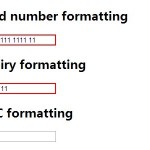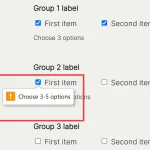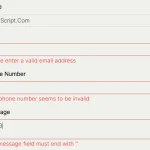| Author: | Kallenju |
|---|---|
| Views Total: | 108 views |
| Official Page: | Go to website |
| Last Update: | November 13, 2023 |
| License: | MIT |
Preview:

Description:
A lightweight, flexible, simple-to-use, developer-friendly form validation library written in PURE JavaScript.
Unlike other form validation libraries with complex, predefined rules, simpower-validation checks user-defined validation rules using Regex and inserts error or success messages into your web page. Callbacks allow reacting to the overall form validation result or individual field failures.
How to use it:
1. Install and import the simpower-validation.
# NPM $ npm i simpower-validation
// ES Module import SimpowerValidation from 'simpower-validation'; // Browser import SimpowerValidation from '/path/to/simpower-validation.esm.js'; // From A CDN <script src="https://cdn.jsdelivr.net/npm/simpower-validation/simpower-validation.production.min.js"></script>
2. Create empty containers that will hold the error & success messages.
<!-- Your Form --> <form id="form"> <label for="name"Username:</label> <input id="name" name="name" type="text" placeholder="Your Username" /> <label for="email">Email:</label> <input id="email" name="email" type="email" placeholder="Your email address" /> <button type="submit">Submit The Form</button> </form>
<!-- Messages --> <div id="all"> Error/Success messages for all form fields will be placed here. </div> <div id="email"> Error/Success messages for the email field will be placed here. </div>
3. Initialize the SimpowerValidation on your HTML form.
const validator = new window.SimpowerValidation('#form', {
validateFieldOnEvent: {
fieldValueHandler(fieldValue) {
return fieldValue;
},
ruleErrorMessages: {
on: true,
position: {
append: '#all',
},
removeContainerFromDOMAfterSuccess: true,
// custom CSS classes for error messages
classes: ['message', 'message-error'],
},
successfulValidationMessage: {
on: true,
successMessage: 'Validation succeeded',
position: {
append: '#all',
},
removeContainerFromDOMAfterFail: true,
classes: ['message', 'message-success'],
},
invalidViewOfField: {
on: true,
classes: ['input-invalid'],
},
validViewOfField: {
on: true,
classes: ['input-valid'],
},
},
});4. Add validation rules using Regex and JS functions. Here are some useful resources to find the perfect Regex.
validator
// validate username
.addField('name', [
{
validator(inputValue) {
return inputValue.trim();
},
errorMessage: 'Usrname is required',
},
{
validator(inputValue) {
const nameRegEx = /^[a-zA-Z]{1,40}$/;
return inputValue.match(nameRegEx);
},
errorMessage: 'Name is invalid',
},
])
// validate email address
.addField(
'email',
[
{
validator(inputValue) {
if (!inputValue.trim()) {
return true;
}
const emailRegEx =
/^(([^<>()[\]\\.,;:\s@"]+(\.[^<>()[\]\\.,;:\s@"]+)*)|(".+"))@((\[\d{1,3}\.\d{1,3}\.\d{1,3}\.\d{1,3}])|(([a-zA-Z\-0-9]+\.)+[a-zA-Z]{2,}))$/;
return inputValue.match(emailRegEx);
},
errorMessage: 'Email is invalid',
},
],
// override options for specific form fields
{
event: 'input',
ruleErrorMessages: {
position: {
append: '#email',
},
},
successfulValidationMessage: {
position: {
append: '#email',
},
},
}
);
// more rules here5. All possible options.
validateFieldOnEvent: {
// JavaScript event to trigger form validation
event: null,
// validate form fields after the first submition
afterFirstSubmition: true,
// disable the form fields during form validating
lockInputOnValidation: false,
// a function to handle field values
fieldValueHandler: null,
// options for error messages
ruleErrorMessages: {
on: true,
position: null,
container: null,
removeContainerFromDOMAfterSuccess: true,
classes: null,
},
// options for success messages
successfulValidationMessage: {
on: false,
successMessage: null,
position: null,
container: null,
removeContainerFromDOMAfterFail: true,
classes: null,
},
// options for valid/invalid views of form fields
invalidViewOfField: {
on: false,
classes: null,
},
validViewOfField: {
on: false,
classes: null,
},
},
validateOnSubmit: {
// disable the form on validate
lockFormOnValidation: false,
// re-validate all fields before submitting
revalidateAllFieldsBeforeSubmition: false,
},6. Event handlers.
validator.onStartValidation(callback: function, eventName: string): validation validator.onEndValidation(callback: function, eventName: string): validation validator.onSuccess(callback: function, eventName: string): validation validator.onFail(callback: function, eventName: string): validation










